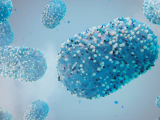A new study from the United Kingdom shows widespread monkeypox DNA surface contamination in healthcare settings, with 93% of surfaces in occupied patient rooms contaminated, and significant contamination on healthcare worker personal protective equipment (PPE).
The researchers were also able to isolate infectious virus from two samples, including an air sample.
The study, published in The Lancet Microbe, was based on testing completed on four respiratory isolation rooms in the Royal Free Hospital in London. The rooms were occupied at various times from May 24 to Jun 17, 2022, by six patients with confirmed symptomatic monkeypox.
In addition to PPE, 60 surfaces in the rooms were swabbed, and air samples were collected from patient rooms (including before and during bedding changes), anterooms, and corridors adjacent to isolation rooms, the authors said.
PPE swabbing revealed DNA on 4 of 12 surfaces, including two each of facial covering visors and gloves.
Viable virus found in 2 samples
Of 20 air samples taken, 5 (25%) were positive, including 3 of 4 air samples collected before and during a bedding change.
Replication-competent virus was identified in 2 (50%) of 4 samples selected for viral isolation, including from air samples collected during bedding change, and from a swab sample of an anteroom floor, the authors said.
"Detection of infectious monkeypox virus in air samples collected during a bedding change highlights the importance of suitable respiratory protection equipment for health-care workers when performing activities that might suspend infectious material within contaminated environments," the authors said.
The authors caution, however, that detection of replication-competent virus in environmental samples does not mean that transmission leading to infection would necessarily occur.
However, the authors also said their findings could have wider public health implications. "The environmental contamination findings could be relevant to public health measures for other spaces and settings where individuals with monkeypox spend prolonged periods, such as residential bedrooms and bathrooms," they write.
"Further investigation is required into the contamination of areas occupied for shorter periods of time, such as outpatient clinics, and health-care spaces that do not have mechanical negative pressure ventilation."
In a commentary on the study, authors from Niger Delta University wrote, "The identification of viable monkeypox virus in air samples during bedding changes is novel and noteworthy, especially as the only confirmed case of healthcare-associated monkeypox in non-endemic countries was associated with the changing of bedding in a patient room."
That case was in 2018 in the United Kingdom.
The authors of the commentary write that historically, there have been fewer than 12 documented cases of healthcare-associated human monkeypox during African outbreaks.
Android app to detect lesions
In other monkeypox research news, a mobile app for Android phones is now able to use deep learning to offer a preliminary monkeypox diagnosis based on users' pictures of rashes.
"The system allows monkeypox suspects to conduct preliminary screening from home comfort using their mobile devices. It enables infected people to take action in the early stages of the infection," the authors said.





















